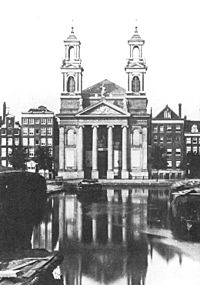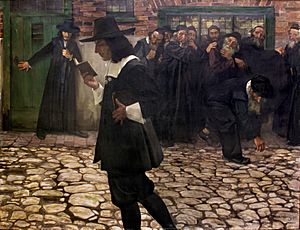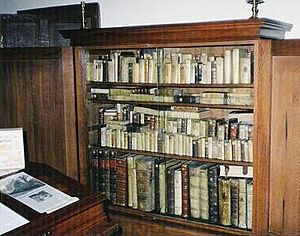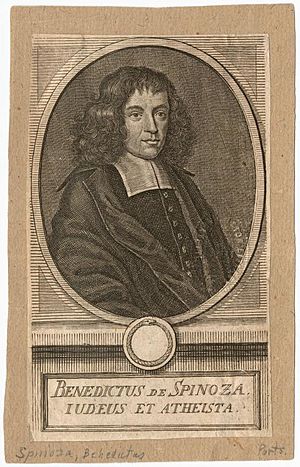Baruch Spinoza
Quick facts for kids
Baruch Spinoza
|
|
|---|---|
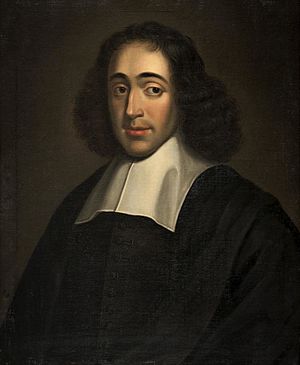 |
|
| Born |
Baruch Espinosa /
Bento de Spinosa 24 November 1632 |
| Died | 21 February 1677 (aged 44) The Hague, Dutch Republic
|
| Other names | Benedictus de Spinoza |
| Education | Talmud Torah of Amsterdam (withdrew) University of Leiden (no degree) |
| Era | 17th-century philosophy Age of Enlightenment |
| Region | Western philosophy |
| School | Rationalism Spinozism Cartesianism Foundationalism (according to Hegel) Conceptualism Direct realism Correspondence theory of truth |
|
Main interests
|
Ethics, epistemology, metaphysics, Hebrew Bible |
|
Influences
|
|
|
Influenced
|
|
| Signature | |
Baruch Spinoza (born November 24, 1632 – died February 21, 1677) was a famous Dutch philosopher. He was born in Amsterdam to a Portuguese-Jewish family. He is often known by his Latin name, Benedictus de Spinoza.
Spinoza was one of the most important thinkers of the Enlightenment. This was a time in the 17th century when people started to use reason and science to understand the world. He was also a key figure in Rationalism, a way of thinking that says knowledge comes from reason, not just from what you see or hear.
His ideas about God and the universe were very new and sometimes controversial. Because of his different views, the Jewish religious leaders in Amsterdam banned him from their community when he was 23. This ban, called a herem, meant he was cut off from Jewish society, including his own family.
Spinoza lived a simple life. He earned money by grinding optical lenses for microscopes and telescopes. He even worked with famous scientists like Christiaan Huygens. He turned down many offers for teaching jobs and honors.
He died at 44 from a lung illness, possibly from breathing in glass dust while grinding lenses. After his death, his books were banned by the Dutch government and the Catholic Church. They thought his ideas were "blasphemous" (disrespectful to God) and "atheistic" (not believing in God).
Spinoza's ideas covered many areas of philosophy, like metaphysics (the nature of reality), epistemology (how we know things), and ethics (how we should live). His main ideas are found in two books: Theologico-Political Treatise and Ethics. The Ethics was published after he died and became very important in Western philosophy.
Baruch Spinoza's Life Story
Early Years and Family
Baruch Espinosa was born on November 24, 1632, in Amsterdam, Netherlands. His family were Sephardic Jewish merchants from Portugal. His mother, Ana Débora, died when he was only six years old.
Even though he later wrote in Latin, his first language was Portuguese. He also learned Hebrew and Dutch. He went to a traditional Jewish school called a yeshiva.
When he was 17, he left school to help with his family's importing business after his older brother died. His father passed away in 1654 when Spinoza was 21. He followed Jewish customs for mourning his father.
Later, his sister Rebekah tried to claim his inheritance. Spinoza took her to court and won. But then, he gave up his claim and let her have the inheritance. After his father's death, he and his younger brother ran the family business, which had many debts. In 1656, Spinoza legally declared himself an "orphan." This allowed him to use his mother's inheritance to study philosophy and optics.
Learning and New Ideas
Between 1654 and 1658, Spinoza started learning Latin from Franciscus van den Enden. Van den Enden was a former Jesuit priest and a political radical. He likely introduced Spinoza to new philosophical ideas, including those of René Descartes. Spinoza then started using the Latin name Benedictus de Spinoza.
During this time, Spinoza also met people from different Christian groups. These groups, like the Collegiants and Mennonites, often discussed ideas and questioned traditional church rules. Many of his friends were part of these groups. This group of thinkers became known as the Spinoza Circle.
Spinoza's ideas about Judaism changed over time. He started to question if the Torah (the first five books of the Hebrew Bible) was truly written by God. This was a big change from traditional beliefs. He even said that God might have a body, which was a very controversial idea. He was once attacked with a knife outside the synagogue by someone who called him a "Heretic!" He kept his torn cloak as a reminder of this event.
Expelled from the Jewish Community
On July 27, 1656, when Spinoza was 23, the Jewish community in Amsterdam issued a cherem against him. This was a very strong ban, like an excommunication, meaning he was shunned and expelled.
The exact reason for the ban was not fully stated. It mentioned his "abominable heresies" and "monstrous deeds." Historians believe there were several reasons:
- His Radical Ideas: Spinoza openly shared ideas that would later appear in his books. He questioned the idea of an immortal soul and a God who directly controls human events. He also believed that Jewish law was no longer binding.
- Community's Reputation: Many Jews in Amsterdam had fled from the Spanish Inquisition and Portuguese Inquisition. They worried that Spinoza's controversial views could cause problems for their whole community. They wanted to show the authorities that they followed strict Jewish law.
- His Own Actions: Spinoza had likely already started to distance himself from the synagogue. He might have stopped attending services and contributing financially. He also went to a civil court instead of the synagogue's court to settle his inheritance dispute, which was against some Jewish rules.
When he was told about the ban, Spinoza reportedly said, "Very well; this does not force me to do anything that I would not have done of my own accord." Unlike most bans, Spinoza's was never lifted because he did not change his views.
After the ban, Spinoza did not become a Christian. He kept his Latin name, Benedict de Spinoza, and stayed connected with Christian groups like the Collegiants. He was even buried in a Protestant churchyard. He believed that truth came from how you interpret religious texts, not just from the texts themselves.
Later Life and Work
Spinoza spent the rest of his life studying and writing. After the ban, the Amsterdam authorities briefly expelled him from the city. He soon returned, living quietly for several years. He gave private philosophy lessons and continued grinding lenses.
In 1660 or 1661, Spinoza moved to Rijnsburg, where the Collegiants had their main center. Here, he started working on his most famous book, the Ethics. In 1663, he published Descartes' "Principles of Philosophy", the only book published under his own name during his lifetime. He then moved to Voorburg.
Life in Voorburg
In Voorburg, Spinoza kept working on the Ethics. He also wrote to scientists and thinkers across Europe. In 1670, he published his Theological-Political Treatise. This book argued for a government that was separate from religion and supported the leader of Holland, Johan de Witt.
The book was published anonymously, but people soon found out who wrote it. It was criticized as being "forged in Hell by a renegade Jew and the Devil." It was officially banned in 1674.
Lens Grinding and Science
Spinoza made a living by grinding lenses and making scientific instruments. He was very skilled at this. Scientists like Christiaan Huygens praised the quality of his lenses. He made lenses for telescopes and microscopes. His work was so good that even after his death, his grinding tools were used to make high-quality lenses.
He also received small, regular donations from his close friends, which helped him financially.
Moving to The Hague and Final Years
In 1670, Spinoza moved to The Hague. He continued working on the Ethics and other writings. He was offered a job as a philosophy professor at the University of Heidelberg, but he turned it down. He probably wanted to keep his freedom of thought and not be limited by a university.
Spinoza's health began to worsen in 1676. He died on February 21, 1677, at the age of 44. His early death was likely caused by a lung illness, possibly silicosis, from breathing in glass dust while working on lenses.
Spinoza's Philosophy: Understanding Reality
Spinoza's ideas are often grouped with those of Leibniz and René Descartes. This group is called the rationalist school of thought. Rationalists believe that we can understand truth through logic and clear ideas, much like how mathematics works. Spinoza used a style similar to Euclid's geometry, with definitions and axioms, to explain his ideas.
Metaphysics: The Nature of Everything
Spinoza's metaphysics is about understanding what reality is made of. He believed there is only one basic thing, which he called "substance." This substance is absolutely infinite, causes itself, and is eternal. He called this substance "God" or "Nature" and used these words to mean the same thing ("Deus sive Natura").
For Spinoza, the entire natural universe is made of this one substance—God or Nature. Everything we see and experience is just a different way this one substance appears.
Substance, Attributes, and Modes
Spinoza defined "substance" as something that exists by itself and can be understood without needing anything else. It doesn't depend on anything for its existence.
A "mode" is something that cannot exist on its own. It must be part of something else. For example, a specific tree is a mode of Nature. It depends on Nature to exist.
An "attribute" is how our minds understand the essence of this substance. Spinoza believed there could be an infinite number of attributes. We only know two: thought and extension (physical space).
Spinoza believed that God is "a substance with infinite attributes." Since nothing can stop such a being from existing, God must exist. He went further, saying that only God exists. This means "Whatever is, is in God, and nothing can exist or be conceived without God." This idea is called pantheism, where God is the same as the universe itself.
He also said that "the mind and the body are one and the same thing." They are just seen in different ways: as thought or as physical extension. Spinoza believed that God is "the sum of the natural and physical laws of the universe." Everything is a part of God.
Spinoza argued that things could not have happened any other way than they did. This means concepts like 'freedom' and 'chance' are not very meaningful. He thought that people are aware of what they want, but not always of the true reasons behind their desires.
Causality: Everything Has a Reason
Spinoza strongly believed in the idea that everything has a reason or a cause. This means that for every event or phenomenon, there is always a cause that explains why it happened. He rejected the idea that things happen for a final purpose, except maybe for human actions.
Spinoza's ideas are sometimes called "Epicurean materialism." This is because he disagreed with Descartes' idea that the mind and body are completely separate. Like the Epicureans, he believed in a physical reality. However, Spinoza believed in strict determinism, meaning everything is decided by causes, unlike the Epicureans who believed in random events.
Emotions and Understanding
Spinoza thought that emotions are connected to our thoughts. He believed that understanding the true causes of our emotions can help us change them from passive (things that happen to us) to active (things we choose). This idea is similar to some modern psychological concepts.
Ethical Philosophy: How to Live Well
Spinoza's idea of "blessedness" is central to his ethics. He believed that blessedness, or true freedom, comes from a "constant and eternal love of God."
This means understanding yourself as part of the one infinite Substance (God or Nature). When you truly understand how you fit into the universe, you achieve a kind of completeness and peace. This understanding leads to an "intellectual love of God," which is the highest state a person can reach.
Spinoza's Writings
When his book Theologico-Political Treatise was published anonymously, it caused a lot of negative reactions. Because of this, Spinoza decided not to publish more of his works during his lifetime. He was very cautious. He even had a special signet ring with the word caute (Latin for "cautiously") under a rose, a symbol of secrecy.
His most important work, the Ethics, and other writings were published after his death in a collection called Opera Posthuma. His friends published them secretly to avoid them being seized or destroyed. The Ethics is written in a very structured, mathematical way, like Euclid's geometry. It is considered a complex but brilliant masterpiece.
Spinoza's Lasting Impact
Many famous philosophers have praised Spinoza. Hegel said that understanding Spinoza is a test for modern philosophy. Gilles Deleuze called him "the 'prince' of philosophers."
Some people have noticed similarities between Spinoza's philosophy and Eastern traditions, like Vedanta from India. They found that his ideas about God and reality were very similar to ancient Indian beliefs.
Albert Einstein, the famous scientist, said that Spinoza was the philosopher who influenced his world view the most. Einstein believed in "Spinoza's God," which he described as the orderly harmony of the universe, not a God who interferes with human lives.
Leo Strauss saw Spinoza as a key figure in the Age of Enlightenment and the beginning of modern Jewish thought. Jonathan Israel argued that Spinoza was the main challenger of traditional religious ideas and political authority in his time.
Spinoza is an important historical figure in the Netherlands. His portrait was on the Dutch 1000-guilder banknote before the euro. The highest scientific award in the Netherlands is called the Spinozaprijs. In 2014, a copy of his Tractatus Theologico-Politicus was placed in the Dutch Parliament, alongside the Bible and the Quran.
Debate About His Excommunication Today
In modern times, there has been a discussion among Israeli politicians and rabbis about whether Spinoza's ban should be lifted. However, the chief rabbi of the Amsterdam Jewish community has decided not to lift the ban. He believes Spinoza's ideas are still too different from traditional Jewish beliefs.
Remembering Spinoza
- The Spinoza Lyceum, a high school in Amsterdam, is named after him and has a statue of him.
- The Spinoza Havurah, a Humanistic Jewish community, is named in his honor.
- A statue of Spinoza by Nicolas Dings was put up in Amsterdam in 2008. It has an inscription that says, "The objective of the state is freedom," a quote from his work.
Images for kids
See also
 In Spanish: Baruch Spinoza para niños
In Spanish: Baruch Spinoza para niños


